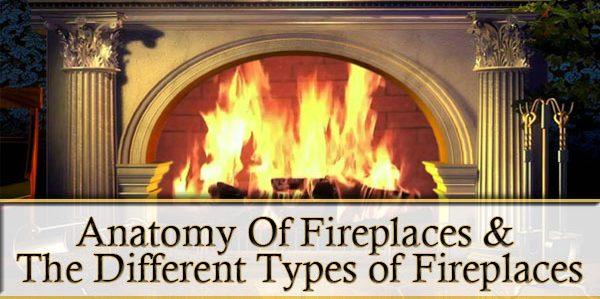When most people think of chimneys, they think of fireplaces. Memories of cold winter evenings, relaxed and cozy in front of a crackling fire are hard to beat, and the ability of an open fire to soothe the wild beast within us all is legendary. Since the dawn of time, humans have gathered around the open fire for a sense of safety and community, and the fireplace is still the focus of family living in many homes, especially around the holidays. But in spite of all the glowing aesthetics, there are some practical considerations. When you’re dealing with an element as capricious and potentially dangerous as fire, knowledge really is power, so please read on to learn how to make your fireplace both safer and more enjoyable.
Let’s start with a quick anatomy lesson, and a brief explanation of commonly used terms:
Fireplaces come in 4 general types, masonry fireplaces built entirely of bricks, blocks or stone and mortar, insert fireplaces, prefabricated fireplaces and factory built or prefabricated fireplaces consisting of a lightweight metal firebox and a metal chimney. (There are a few hybrids too, the most common being a heavy metal firebox and smoke chamber coupled to a regular brick chimney). To figure out which you have will take only a moment of detective work on your part.
A masonry fireplace has a firebox built of individual generally yellowish firebrick, a brick chimney above the roof, and if you look up past the damper you will see a roughly pyramid shaped affair also built of brick. A prefab fireplace generally has a firebox of cast refractory panels, and usually some metal is visible in the room all around the firebox. If you look up past the damper you will see a round metal chimney. And above the roof is more round metal chimney, sometimes surrounded by a simulated brick housing. Although basically similar, there are some important differences. We have provided areas with some special considerations for masonry or prefabricated fireplaces that you can jump directly to by clicking the appropriate name.
Masonry Fireplaces
Masonry fireplaces, built entirely of bricks, blocks or stone and mortar, are massive structures often weighing between 6 and 7 tons! They are aesthetically pleasing, long lasting, and add real value to your home. With a little care and periodic maintenance they can literally give you a lifetime of enjoyment.
Masonry fireplaces require an extensive footing capable of supporting their great bulk, and if not provided with one will often shift and crack, allowing the fire to escape to nearby combustibles. You should always keep an eye out for any signs of settling or movement. Just inside the firebox, where the facing material meets the firebrick, is one weak spot where this settling is often first apparent. Keeping downspouts directed away from the fireplace and careful sloping of the ground around the fireplace to be sure water runs away from the structure can keep settling problems to a minimum.
Although masonry is quite durable, and in fact is often seen as indestructible, this is certainly not the case, especially for a chimney. While the rest of the brick on the house is somewhat protected by the eave, the poor chimney is sticking up like a flagpole, exposed to every raindrop and freeze/thaw cycle. A quality chimney cover, keeping the crown in good repair, and a waterproofing treatment, are money well spent to avoid expensive repairs or rebuilding. See the section on waterproofing for a more detailed explanation.
The firebox of course takes the brunt of the fire’s heat and it requires some special attention. The firebrick can take the heat pretty well, but the joints will fail in time from the constant expansion and contraction. In addition, refractory mortar is specified and seldom used. In a fireplace without a chimney cover, the rain water will also pool on the smoke shelf, mix with the soot behind the damper, and form an acidic slurry that seeps into the fire back destroying the mortar joints. These joints must be kept in good repair with a high temperature refractory mortar to ensure the fire is contained.
The tile liners used in most masonry fireplaces are just fine as long as the fireplace is properly maintained and not exposed to chimney fires. One good chimney fire will usually crack these tiles, rendering them incapable of performing their intended function. The general rule of thumb is that a masonry fireplace should be cleaned before 1/4″ of soot accumulates. If you ever do experience a chimney fire, it is very important to have the chimney swept and inspected before it is used again. We suggest a side trip to the areas on Chimney Fires and Liners for further information.
Unlike prefabricated fireplaces which are factory engineered products, a masonry fireplace is built on site brick by brick, giving the mason ultimate control of the final product. This results in a wide range of masonry fireplaces available, from long lasting, heat producing beauties, to smoky pits that crumble in a relatively short time. Most masonry fireplaces that chimney sweeps encounter, although far from perfect, can, with a little tender loving care, and carefully considered maintenance procedures, provide you with many peaceful, relaxing hours in an otherwise often hectic world.
Prefabricated Fireplaces
Factory built, or prefabricated fireplaces, are relative newcomers to the fireplace scene, commonly available only for the last 25 years or so. Unlike traditional site-built masonry fireplaces, most factory built fireplaces are made of metal, and come from the factory as complete units with a firebox, a specific chimney system, and all miscellaneous parts. With proper installation and maintenance, they can give years of service, but there are some special considerations owners of these systems should be aware of:
1)The factory-built fireplace and chimney are a complete system, engineered to work safely and efficiently together. Both units(fireplace and chimney), undergo testing together, then are listed specifically for use with each other.
2) The installation instructions must be followed exactly, especially the specified clearances from the firebox and chimney to any combustible materials. Most manufacturers require 2″ minimum air space (no insulation allowed either), between the chimney components and all wood framing. If you are installing a new unit be sure these clearance instructions are strictly adhered to. If you have a unit already installed it is very important you check these clearances wherever possible. Any wood that is too close to the chimney will continue to dry and undergo a process called pyrolisis. It can eventually catch fire at temperatures as low as 200 degrees. Over half of the units inspected by chimney professionals are improperly installed, and a trip to the attic to check clearances is definitely time well spent! It is much more difficult to inspect the firebox clearances, but we suggest you consider installing an access port to both check these clearances and monitor the units condition as the years go by.
3) Most factory built fireplaces are tested and listed as decorative heating appliances and will not withstand the abuse often heaped on their masonry counterparts. Although they are tested to U.L. standards, severe over firing and chimney fires will often badly damage these units. Regular yearly maintenance and careful monitoring can assure a safe enjoyable system.
4) Many prefab chimneys, especially older units with an imitation brick housing above the roof, seem to be a preferred nesting site for birds in many areas. It is not unusual for chimney sweeps to take literally buckets of nesting material from these chimneys. This nesting can catch fire directly, or it can block critical air passageways between layers of metal chimney pipe, allowing the chimney to overheat. Both scenarios routinely cause house fires. Most aftermarket chimney covers do not correctly address the problem, and can often make the situations worse. A careful screening of all potential nesting areas with the proper sized screening may be in order.
5) Finally, prefab fireplace systems eventually just plain wear out. Models go out of production and manufacturers go out of business. A factory-built unit will reach the end of its useful life when repair of the unit is no longer possible, particularly if the components that are necessary to maintain the listing are no longer available. Keep a close eye on an aging unit, and be prepared to send ole faithful to the great recycling plant in the sky before she fails completely.
But in spite of all the glowing aesthetics, there are some practical considerations. When you’re dealing with an element as capricious and potentially dangerous as fire, knowledge really is power, so please read on to learn how to make your fireplace both safer and more enjoyable.
Ethanol Burning Vent Free Fireplaces
Fireplaces that burn ethanol or gas fireplaces have been becoming more popular in 2015 for their minimalistic look and clean burn/mobile friendly capabilities of them. These types of fireplaces push towards biofuels and being eco friendly. It burns on denatured ethanol so you don’t have to hook up any utilities and also means that you won’t have to clean up any ashes or worry about smoke.
It’s a smoke-free fireplace. They can be installed quickly as a freestanding unit or can be built-in to your specifications. It also doesn’t need a chimney which means all the heat will stay in the home. These ethanol burning fireplaces can be installed for as little as $850 or you can go with one of the top units all the way up-to $13,000.
Insert Fireplaces
If you are looking to buy a new fireplace or just looking to upgrade your inefficient one, an insert fireplace unit could be what you are looking for. They are also energy efficient and insert fireplaces come in modular boxes that can be installed into any opening or one that already exists. The inserts circulate warm air well and can be configured in multiple ways: vent free, wood burning, direct vent, gas, pellets and more…
The best configuration set up is with using glass doors to control the heat flow and use the outside air as a combustion intake, which will use the air outside to burn rather than your air indoors. If you configure this fireplace correctly it can be a huge source of heat for single rooms or sometimes a whole home. These units usually run between $600-$1,900.
Learn more about the different types of masonry walls and masonry mortar types.





